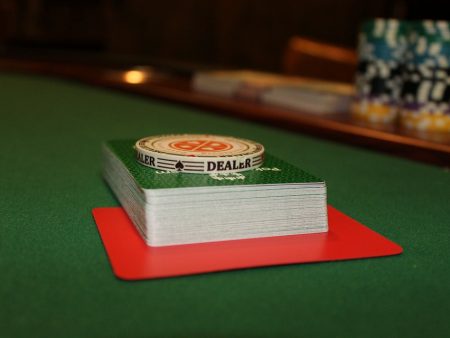

In the game of poker, you won’t be able to predict whether your opponent has a good hand or a bad one until it’s too late. We can state that poker is a game based on observation and availability of information.
With intricate observation, you can analyze your opponent’s move because of the human interaction which happens in the game. If you pay attention, you will receive enough clues based on their playing patterns and physical demeanor, which can indicate whether your rival has an upper or a lower hand. In the game of poker, reading observations is called “poker tells.”
Understanding the art of ‘poker tell’ is highly rewarding. It gives you a head start if you can successfully read and decode other players’ tells, especially if you can execute it subtly.
Two Types Of Poker Tells
Poker tells can be classified into two types:
- Betting patterns
- Physical tells
What Is A Betting Pattern?
Let’s begin by understanding the most reliable form of poker tells, the betting patterns. How often have you heard the phrase which tells that history has a pattern to repeat itself? At least once in our lives, right?
If you think about it, it also stands true. Future can be predicted based on the past, at least in the game of poker. The more you study your opponent’s moves based on his history, the more advantage you will have. For instance, your analysis of your opponent’s past betting will give you an idea of whether they are an aggressive player or not, how they react when they have a strong hand compared to the reaction when they have a weak one.
These inherent patterns usually stay with us until we make an effort to modify them. Therefore, with a little bit of practice and attention, you will be able to master the art of poker tells.
What Are Physical Tells?
As the term suggests, physical tells are about physical actions and demeanors. These actions are also dramatized in televisions and movies to create confusion and are fun to observe.
Physical tells are more useful in live poker, where your observation skills can detect critical hints that can be beneficial for you. Unless you’re a physiatrist or a behaviorist, mastering the art of poker tells will take some time and lots of practice.
Not As Easy As It Seems
Many of you might wonder, ‘So, all I need to do is observe and be alert? That sounds easy!’ but it’s not. Implementing tells in the game is very different than in theory because it can differ from player to player. Moreover, you will need some experience to understand whether your rival is bluffing or whether the poker tell is reliable.
It’s no magic, and hence, it’s hard. Cliche! But executing accurate poker tells will need time and experience. If you want to excel at understanding poker tells, you will have to implement observing in your daily life.
Once you start doing that, you will learn to notice, first consciously and eventually, unconsciously, how the trick works. Generally, the shortest tell is a reliable one, and the first tell is often genuine.
Contrarily, the long and drawn-out tells are forceful and false. Remember how in movies, players try to fool each other by being sad but eventually takes all the money? The rule of poker tells to works that way.
It states that if someone depicts weakness, in reality, its strength and showcasing strength means liability. But, as mentioned above, this is not valid for all the players. Therefore, you must decide how you will allow these poker tells to affect your game.
List Of Common Poker Tells
Let’s divide the common tells into groups.
- Before the card is in the air.
- Poker tells, which indicates a firm hand.
- Poker tells, which showcases weak hands.
Before The Card Is In The Air.
- Analyze the first impression. Typically, a conservative style of dressing indicates a conservative approach to play.
- Observe whether your opponent’s buy-in for a short rack or go for a full one.
- Players who are loud and flashy often reveal that while buying their chips and during their money-waving act.
- You can also indicate a sloppy play style in a player if you observe that the chip stack is untidy.
- Poker tells can help you figure out whether a player is a pro or an amateur based on the way they handle their chips.
Indicating Strong Hand
Following observations can indicate a strong hand:
- Full relaxed lips.
- Shaking hands.
- Fluid speech.
- Eyes open, not blinking.
- Observe through the corner of the eyes and stare at the flop.
- Blood pressure is up. The face is red, or the vein in the neck or head is throbbing.
- A full, ear to ear, relaxed smile.
- Impatient and wants to bet.
- Constantly checking out your or their own chip stakes.
- The classic weakness indicates strength strategy by sounding nervous, sighing, or shrugging.
These are some of the essential poker tells which can be associated with reliable poker tells. While many experts suggest observing the eyes, and you must! But I also think you should check out their hands. Trembling hands in poker often indicates excitement, which is a genuine poker tell.
Indicating Weak Hand
- Unnatural speech like forced, slow, broken, incoherent tone.
- Using brute force to put chips in the pot.
- Not moving and holding the breath.
- Carelessly managing their cards
- Stares into the blank space and inhales after the miss
- Worried and breathing through the mouth
- Showing strength like staring right at you.
- Lips get smaller and tensed.
- Eyeballs rolling along with eyes blinking and squinting.
- Hand over eyes
- Biting nails
- Fake smiles
That concludes the mini-list of signs indicating weak hands. Keep them in mind and notice if you spot these signs the next time you play.
Now that we are aware of the signs of poker tells, let’s go through some fundamentals of poker tells which will help you ace the game.
Beginner Poker Tells
It is imperative to keep in mind not to overdo or over-think while playing, as it can throw you off your game. Therefore, consider the level of your opponent before building a strategy. In general, a beginner won’t know much about poker tells, or even if he knows, he won’t be able to execute it due to lack of experience.
In such cases, don’t waste too much time reading body language. Just observe and apply the apparent rules, and you will be good.
Online Poker Tells
The disadvantage of online poker tells is that you can’t physically observe your opponent. Therefore, the physical cues we discussed above are nearly useless in online games.
Here, you have to use the most reliable poker tell betting pattern. Your strategy should be based on observing the changes in your opponent’s betting pattern in online poker. You must also follow their timing.
If a player is thinking a lot before putting out his card, it can indicate a weak hand. Whereas a faster call usually sums up to a firm hand. However, because you’re playing online, timings might not always be reliable.
Practice Is Essential
As mentioned before, poker tells is a skill that you have to develop over time. Just like any other skill, it needs time, patience, and lots of practice. Initially, you will confuse the cues, and it will be frustrating, and that’s okay. It’s a part of the process, so relax.
Take small steps. Start by paying attention to individual players during your poker season. Showdowns are crucial to watch, therefore, run replays if you want but observe how the behavior of your rival and how his hands turn up.
It is also imperative to understand that your observations should happen when your rival is playing his hand, not at the expense of your turn. All this might sound a bit overwhelming, but eventually, you will reach a point where you will start noticing the patterns while having fun.
Summing Up
The significance of studying betting patterns and playing styles is indeed much more than poker tells. But mastering these tells is fun, and it gives you an edge over other players as most people don’t pay much attention to the tells.







